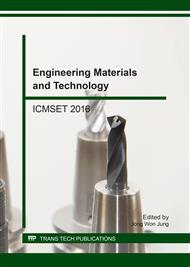[1]
A. Demirbas, Comparison of transesterification methods for production of biodiesel from vegetable oils and fats, Energy Convers Manage. 49 (2008) 125–130.
DOI: 10.1016/j.enconman.2007.05.002
Google Scholar
[2]
J. Jiménez Ramírez, A. Campos Villanueva, M. Martínez Gordillo, Dos especies nuevas del género JATROPHA de la sección PLATYPHYLLAE (EUPHORBIACIAE). Anales Inst. de Biol., Univ. Nacional Autón. México, Ser. Bot. 65 (1994).
DOI: 10.21829/abm30.1995.728
Google Scholar
[3]
Sanchez-Sanchez, A. Perez-Vazquez, J. Caplan, The Mexican Non-toxic Jatropha curcas L., Food Resoursce or Biofuel?, Ethnobot. Res. Appl. 11 (2013) 1–7.
Google Scholar
[4]
A.C. Dimian, C.S. Bildea, F. Omota, A.A. Kiss, Innovative process for fatty acid esters by dual reactive distillation, Computers & Chem. Eng. 33 (2009) 743–750.
DOI: 10.1016/j.compchemeng.2008.09.020
Google Scholar
[5]
B. Freedman, E.H. Pryde, T.L. Mounts, Biodiesel production from oils and fats with high free fatty acids, J. Am. Oil Chem. Soc. 61 (1984) 1638–1643.
DOI: 10.1007/bf02541649
Google Scholar
[6]
A.K. Tiwari, A. Kumar, H. Raheman, Biodiesel production from Jatropha oil (Jatropha curcas) with high free fatty acids: an optimized process. Biomass Bioenerg. 31 (2007) 569–75.
DOI: 10.1016/j.biombioe.2007.03.003
Google Scholar
[7]
Ghadge SV, Rahema H. Process optimization for biodiesel production from Mahua (Madhuca indica) oil using response surface methodology. Bioresour Technol. 97 (2006) 379–84.
DOI: 10.1016/j.biortech.2005.03.014
Google Scholar
[8]
A.K. Domingos, E.B. Saad, H.M. Wilhelm, L.P. Ramos, Optimization of the ethanolysis of Raphanus sativus (L. Var. ) crude oil applying the response surface methodology. Bioresour Technol. 99 (2008) 1837–45.
DOI: 10.1016/j.biortech.2007.03.063
Google Scholar
[9]
A. Bouaid, L. Bajo, M. Martinez, J. Aracil, Optimization of biodiesel production from jojoba oil. Trans IChemE. 85 (2007) 378–82.
DOI: 10.1205/psep07004
Google Scholar
[10]
X. Chen, W. Du, D. Liu, Response surface optimization of biocatalytic biodiesel production with acid oil. Biochem Eng. J. 40 (2008) 423–9.
DOI: 10.1016/j.bej.2008.01.012
Google Scholar
[11]
J.S. Kwak, Application of Taguchi and response surface methodologies for geometric error in surface grinding process, Int. J. Mach. Tool Manuf. 45 (2005) 327–34.
DOI: 10.1016/j.ijmachtools.2004.08.007
Google Scholar
[12]
N. Aslan, Application of response surface methodology and central composite rotatable design for modeling the influence of some operating variables of a Multi-Gravity Separator for coal cleaning. Fuel. 86 (2007) 769-776.
DOI: 10.1016/j.fuel.2006.10.020
Google Scholar
[13]
J.S. Box GEP, J.S. Hunter, Multi-factor experimental design for exploring response surfaces, Ann. Math. Stat. 28 (1957) 195–241.
DOI: 10.1214/aoms/1177707047
Google Scholar
[14]
D.P. Obeng, S. Morrell, T.J.N. Napier, Application of central composite rotatable design to modeling the effect of some operating variables on the performance of the three-product cyclone, Int. J. Miner Process. 769 (2005) 181–192.
DOI: 10.1016/j.minpro.2005.01.002
Google Scholar
[15]
Y.S. Hung, Y.H. Chen, N.C. Shang, C.H. Chang, T.L. Lu, C.Y. Chang, J.L. Shie, Comparison of biodiesels produced from waste and virgin vegetable oils, Sustain. Environ. Res. 20 (2010) 417–422.
Google Scholar
[16]
U. Rashid, F. Anwar, M. Ashraf, M. Saleem, S. Yusup, Application of response furface methodology for optimizing transesterification of Moringa oleifera oil, Energy Convers Manage. 52 (2011) 3034–3042.
DOI: 10.1016/j.enconman.2011.04.018
Google Scholar


